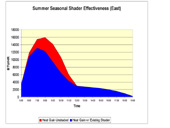

(seasonal shading effectiveness graphs)
(Due to the symmetrical nature of the sun’s path, the east and west graphs are mirror images of each other. For clarity, only the east graph is presented here.)
These graphs indicate that the shading devices do have an effect on the pattern of daily solar gains for each orientation. The total gains on the south orientation are reduced by 25% from the unshaded condition. The total gains on the east and west orientation are reduced by 19% from the unshaded condition.

South Orientation

East Orientaion